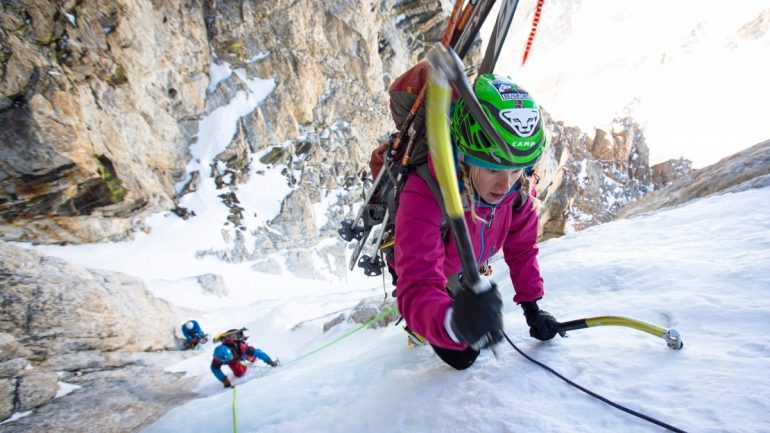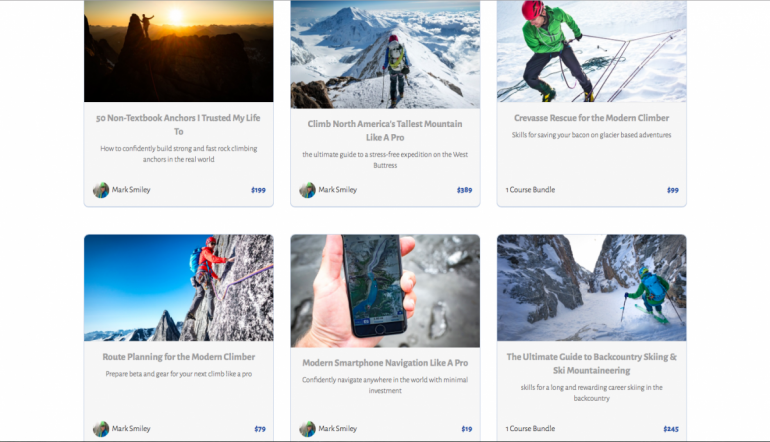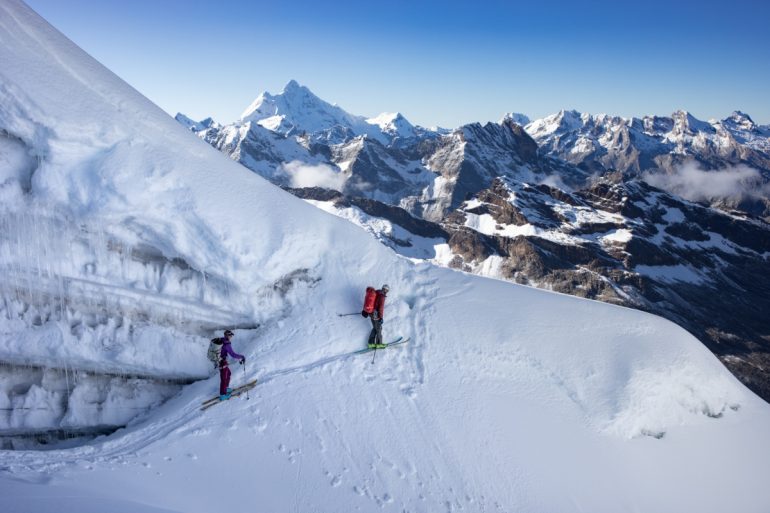This post is sponsored by Cripple Creek Backcountry, our local gear shop committed to outfitting backcountry skiers of all levels and experience.

Mountain Sense’s ski mountaineering course covers everything from avalanche safety to steep skiing, ice climbing, anchor building, gear selection and more. Photo: Mountain Sense
Can you learn to ski mountaineer online?
Among the more obscure things you can learn online these days include: how to survive a shark attack, how to teach your cat how to high-five, how to cut an onion without crying, and now, learn how to ski mountaineer. Yes, even ski mountaineering has joined the modicum of online how-to’s, along with a variety of outdoor education topics such as anchor building, bump skiing and more.
YouTube has long been the staple instructional platform for a variety of outdoor skills (along with everything else), but newly emerging are entire courses that you sign up for, pay for and can access any time you want. They have the advantage of compiling all of the resources available online into one place by a credible expert. To see first hand what outdoor online learning is all about, I signed on for a new class with Mountain Sense, a one-man organization started and run by IFMGA Guide Mark Smiley. Here’s my take on Mountain Sense’s new “Ultimate Guide to Backcountry Skiing and Ski Mountaineering” course.
A personal note: in general, I am skeptical of online courses. During years of teaching in academia, I actively avoided onine teaching because 1. I was already bogged down with grading without the added interactive forums, discussions etc. web-based courses rely on to stimulate an in-classroom learning experience, and 2. web-based platforms are inherently limited. Unless an online course is designed very carefully, it is unlikely to be able to satisfy the various learning styles of the various participants. That said, I was particularly curious to see how the platform could lend itself to something so elementally experiential as mountain travel and ski mountaineering. Let the anticipation build…
Overview of the course
The Mountain Sense ski mountaineering course covers an enormous amount of ground over roughly 6.5 hours of instructional videos broken into five sections. The major sections, including avalanche eduction, skiing skills (uphill and down), gear, anchors and expedition skills, are then broken down into smaller chunks that dig into specific topics. For instance, the subsection Steep Skiing includes “Perfect these four turns to ski anything,” “Huck your meat without hitting your deductible” and “Islands of safety”. Skills oriented topics like “Ice climbing for skiers,” “Booting Up: avoid soul-destroying wallowing” and “Rappelling on super duper thin cords” are filmed in the field, with Mark talking through specific techniques and pitfalls as though you’re in an outdoor class with him. Other topics like “What’s in my pack”, “Waxing like a champ” and most of the avalanche basics are filmed in (presumably) Mark’s garage to give you a sort of dirt bag variation on a classroom. I wouldn’t want that any other way.
Sprinkled throughout the courses are best-of YouTube videos from other sources (beacon check from BCA, for instance), guest instructors including PSIA Level 3 Stephanie Schmitt from Jackson Hole Mountain Resort, and guest speakers such as Exum Mountain Guide Zahan Billimoria on the 40-minute recording of “A Mountain Guide’s Morning Avy Routine.” Cody Townsend even makes an appearance to discuss tips for overcoming fear when dropping into steeps. Mark also links written resources including his own expedition planning and gear lists. The course is a comprehensive, if not exhaustive, compilation of decades of ski mountaineering and guiding experience.

Oh the things you can learn online. The Mountain Sense dashboard offers a growing variety of in-depth options.
Pros
Unlike in-person courses, online courses allow you to rewind, fast forward or review whenever you want. You also don’t need to take time off from work, away from your family or leave your house. Watch a few short segments on anchors before bed. Do a quick refresh of belaying a skier the morning before you head out to practice with your posse.
The course also offers comprehensive knowledge all in one place. For most of us, our know-how of different elements of ski touring is patchwork and dependent on the education of the partners we go out with, the mentors we encounter and whatever more formal education we pursue. Courses, whether online or in person, put all of the information in one place and establish a shared knowledge baseline.
Each video page offers an interactive chat bar. This allows you to ask Mark questions for clarification, banter, or connect with other folks enrolled in the course. Definitely a crucial element for working through some of the more technical topics and it provides direct access to the instructor that you can’t get from a YouTube video.

The course includes numerous video clips from Mark’s ski endeavors to emphasize points and illustrate skills. Photo: Mountain Sense
Cons
The obvious: no hands-on practice under the watchful eye of an instructor. This could be particularly helpful for topics like setting up snow anchors and placing ice screws.
Limited opportunities for assessment. This is where the online aspect gets tricky. Outdoor education is by nature experiential. The lion’s share of its value comes from hand-on practice in low consequence environments where students can mess up and learn. I wonder if a future iteration of the course could include some sort of self assessment. Perhaps students would need to take a photo of an anchor they set or a section of skin track they break, and then discuss the process and decision making. This could help the course be more intensive and applicable in the field.
Concluding thoughts
As I worked through the sections of the course, I repeatedly asked myself who the ideal audience is. Mark offers that it offers something for everyone: it’s a crash course for the total newb, a practical refresher for the novice to proficient, and a reminder for the advanced and expert. I consider myself in the advanced category, my education mostly coming from time in the hills with skiers more experienced than myself and training days when I dip and out of guiding. I gleaned a lot of useful information through the course. The steep skiing section gave me a handful of tangible techniques to practice on-piste this winter. As a tepid (as in, rare) ice climber, I found the “6 rookie mistakes to avoid when ice climbing” helpful, as well as ski belaying and expedition planning. Avalanche terrain protocol reminders are always useful and something I think it’s beneficial for most of us to brush up on throughout the season.
What I found truly impressive is how the course provides such a deep and comprehensive overview of skills and knowledge useful in the practice of ski mountaineering. Mark provides an extensive resource that offers a foundational knowledge base to all who enroll. I’m still divided as to whether online learning is truly effective for a practice as hands on as ski mountaineering, but as with all online learning, self motivation and application are crucial to get the most of it. This is a great starting point for someone who’s curious about the world of ski mountaineering and has limited access to mentors (or is preparing for mentorship) or for someone who wants to ensure they really have their bases covered. The key, though, is practice.
Manasseh Franklin is a writer, editor and big fan of walking uphill. She has an MFA in creative nonfiction and environment and natural resources from the University of Wyoming and especially enjoys writing about glaciers. Find her other work in Alpinist, Adventure Journal, Rock and Ice, Aspen Sojourner, AFAR, Trail Runner and Western Confluence.
